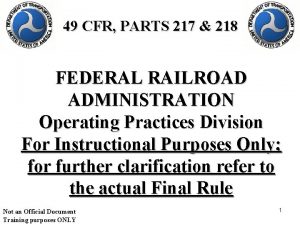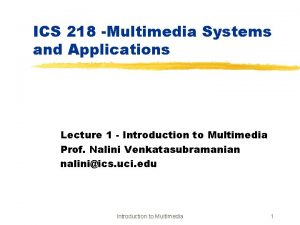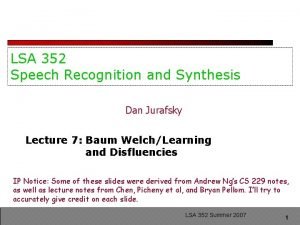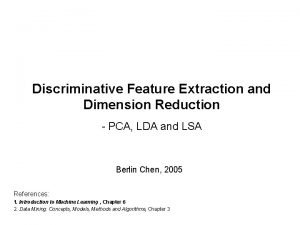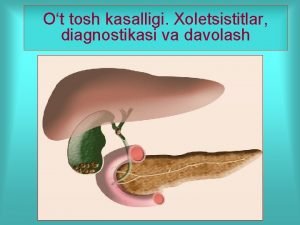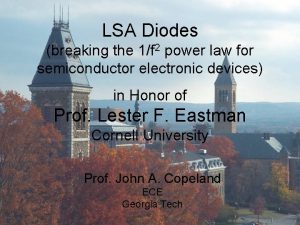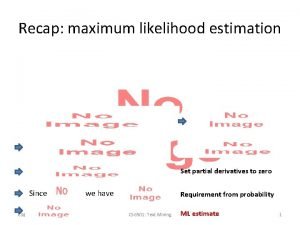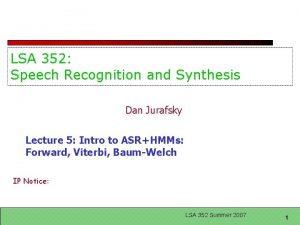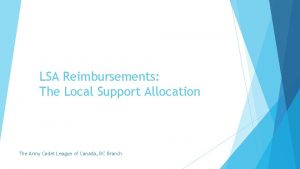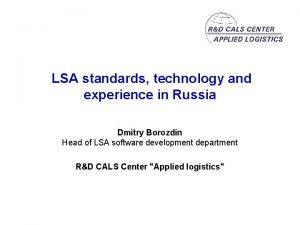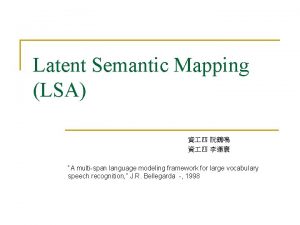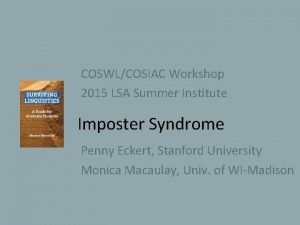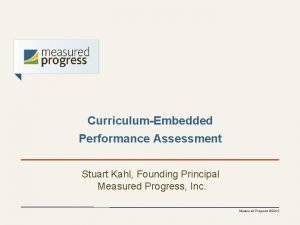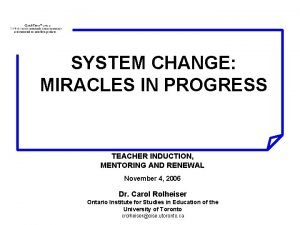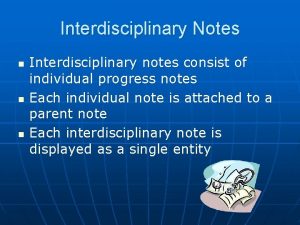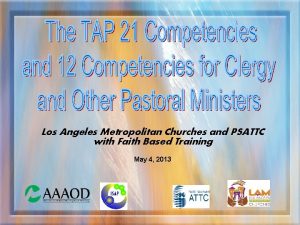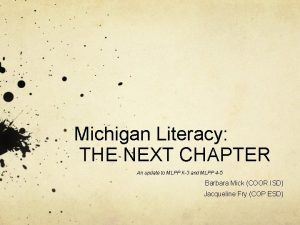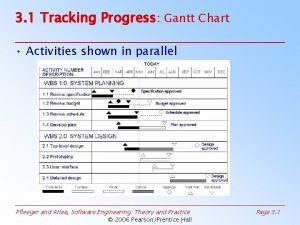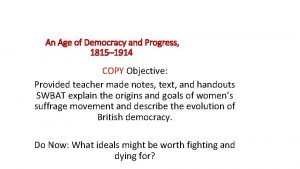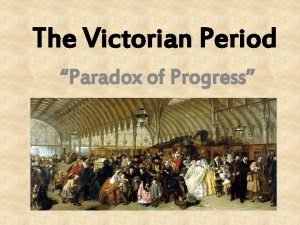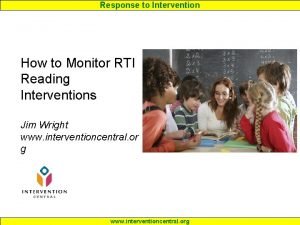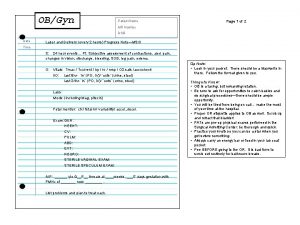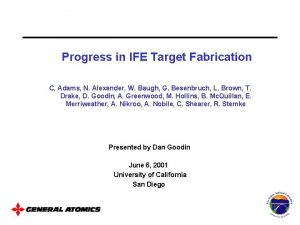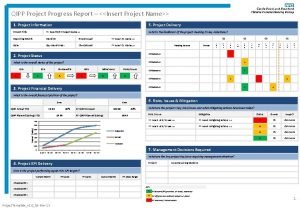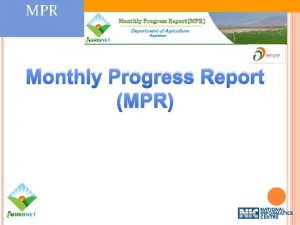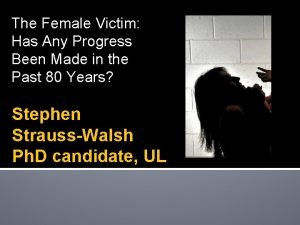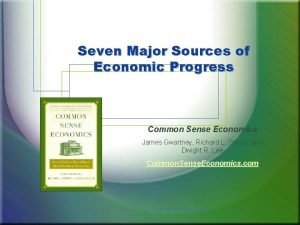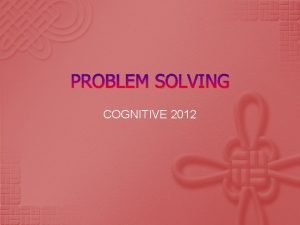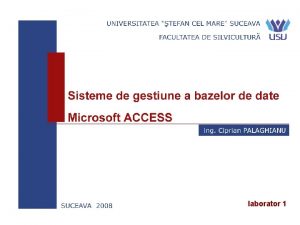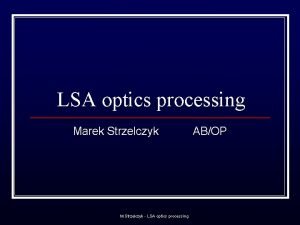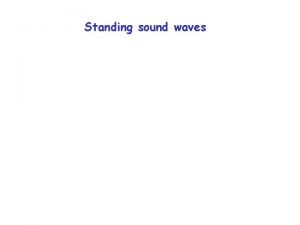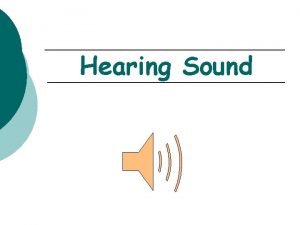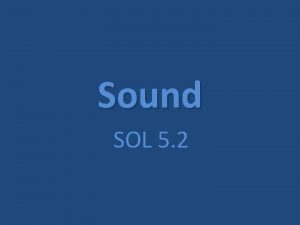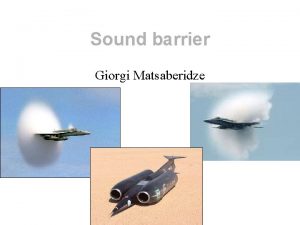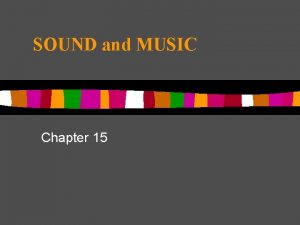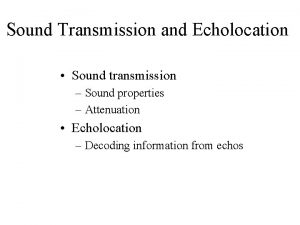LSA 218 Sound change in progress LSA 218
















![The metropolis of Tehran [500, 000] and the neighboring capital of Ghazvin province, [distance: The metropolis of Tehran [500, 000] and the neighboring capital of Ghazvin province, [distance:](https://slidetodoc.com/presentation_image_h2/2885cdfec0ffffd23b49d6f721b2fb84/image-17.jpg)

![Percent raising of /a/ to [u] before nasals by years of education in the Percent raising of /a/ to [u] before nasals by years of education in the](https://slidetodoc.com/presentation_image_h2/2885cdfec0ffffd23b49d6f721b2fb84/image-19.jpg)





















![The short-a pattern of Dr. John (Mac Rebennac) Tense [closed syllable] answer, fancy, hand, The short-a pattern of Dr. John (Mac Rebennac) Tense [closed syllable] answer, fancy, hand,](https://slidetodoc.com/presentation_image_h2/2885cdfec0ffffd23b49d6f721b2fb84/image-41.jpg)



![Optimality constraints on tensing of short-a *æh[+voc]: no tensing before resonants (pal, carry) *æh[-cont, Optimality constraints on tensing of short-a *æh[+voc]: no tensing before resonants (pal, carry) *æh[-cont,](https://slidetodoc.com/presentation_image_h2/2885cdfec0ffffd23b49d6f721b2fb84/image-45.jpg)


















































- Slides: 95

LSA. 218 Sound change in progress LSA. 218 Transmission and diffusion Linguistic Institute Cambridge July 2005

Family tree and wave models of linguistic change The family tree model has been the principal guide and major output of the comparative method. Yet all linguists agree that there are some situations where the effects of a wave model must be recognized, registering the influence of distinct terminal branches of the tree on one another.

Best Indo-European family tree (Ringe, Warnow & Taylor 2002)

A definition of linguistic descent (transmission) A language (or dialect) Y at a given time is said to be descended from language (or dialect) X of an earlier time if and only if X developed into Y by an unbroken sequence of instances of native-language acquisition by children. --Ringe, Warnow and Taylor p. 63

Transmission the result of incrementation üThis is the normal type of internal language change, “change from below, ” which is responsible for increasing distances between the branches over time. üSuch internal changes are generated by the process of incrementation, in which successive cohorts and generations of children advance the change beyond the level of their caretakers and role models, and in the same direction over many generations (Labov 1994: Ch. 14).

The mechanism of incrementation üIncrementation begins with the faithful transmission of the adult system, including variable elements with their linguistic and social constraints (Labov 1989, Roberts 1993). üThese variable elements are then advanced further in the direction indicated by the inherited age vectors. üThe incrementation of the change may take the form of increases in frequency, extent, scope or specificity of a variable. üThough internal changes may simplify the system (as in mergers), they normally maintain structural contrasts (as in chain shifts) or increase it (as in splits).

Fronting of (aw) by age with partial regression lines for sex in Philadelphia Neighborhood Study [N=112]

Regression analyses of fronting of (aw) of men and women by decade in the Philadelphia Neighborhood Study [N=112]

A definition of diffusion We also observe changes that diminish the distances between branches of the family tree. This may happen spontaneously, when parallel branches converge through independently motivated changes, but more often it is the result of contact between the speech communities involved and the transfer of features from one to the other. This transfer across branches of the family tree is here designated linguistic diffusion.

Best family tree with indications of contact between Germanic and Italo-Celtic --Ringe, Warnow & Taylor 2002

Constraints against structural diffusion RWT argue for a strong linguistic constraint against structural borrowing. They state that the essential condition for the family tree model is that morphosyntactic structures are faithfully transmitted across generations, and are not transferred from language to language in normal linguistic development. Though most language contact situations lead to unidirectional, rather than bidirectional linguistic results, conditioned by the social circumstances, it is also the case that linguistic structure overwhelmingly conditions the linguistic outcomes. Morphology and syntax are clearly the domains of linguistic structure least susceptible to the influence of contact, and this statistical generalization is not vitiated by a few exceptional cases. --Gillian Sankoff, Age: Apparent Time and Real Time. Elsevier Encyclopedia of Language and Linguistics, in pres. .

Accounting for the difference between transmission and diffusion. It is proposed here that the contrast in patterns of transmission within and across languages is the result of two different kinds of language learning. On the one hand, transmission is the product of the acquisition of language by young children. On the other hand, the limitations on diffusion are the result of the fact that most language contact is largely between and among adults. It is proposed here that structural patterns are not as likely to be diffused because adults do not learn and reproduce linguistic forms, rules and constraints with the accuracy and speed that children display

Lowering of /æ/ on Brunlanes peninsula: Speakers age 70 - Trudgill 1974: Map 3. 7

Lowering of /æ/ on Brunlanes peninsula: Speakers age 25 -69 - Trudgill 1974: Map 3. 8

Two models of linguistic diffusion The cascade model: change originates in the largest city, diffuses to the next largest city, and so to successively smaller cities. The gravity model: the influence of one city on another is directly proportionate to population size and inversely proportionate to the square of the distance between them (Trudgill 1974)

Question: Why does change diffuse in a stronger form within the metropolis, but in a weaker form to communities without?
![The metropolis of Tehran 500 000 and the neighboring capital of Ghazvin province distance The metropolis of Tehran [500, 000] and the neighboring capital of Ghazvin province, [distance:](https://slidetodoc.com/presentation_image_h2/2885cdfec0ffffd23b49d6f721b2fb84/image-17.jpg)
The metropolis of Tehran [500, 000] and the neighboring capital of Ghazvin province, [distance: 150 km] Tehran Ghazvin

Percent raising of /a/ to /u/ in the Farsi of Tehran and Ghazvin by age and style. Source: Modaressi 1978
![Percent raising of a to u before nasals by years of education in the Percent raising of /a/ to [u] before nasals by years of education in the](https://slidetodoc.com/presentation_image_h2/2885cdfec0ffffd23b49d6f721b2fb84/image-19.jpg)
Percent raising of /a/ to [u] before nasals by years of education in the Farsi of Teheran and Ghazvin Source: Modaressi 1978

Short-a systems in North American dialects All North American dialects show a differentiation of the short-a class into tense and lax forms (ANAE: Ch. 13). There are five basic types: a. The nasal system, All short-a before nasal consonants are raised and fronted (man, manage, span, Spanish) while all others remain in low front position. b. Raised short-a. All words with historical short-a are raised and fronted to mid and high position. Found only in the Inland North. . c. Continuous short-a raising. Short-a words are variably raised and fronted, with vowels before nasal codas leading and vowels before voiceless stops and words with obstruents/liquid onsets (glass, brag) remaining in low front position. . d. Southern breaking. Breaking of short-a into a low front nucleus, palatal glide and following inglide in the Southern dialect area. e. Split short-a systems. A phonemic split between tense and lax short-a is found in New York City and the Mid-Atlantic states, with distribution dictated by phonological, grammatical, stylistic and lexical conditions.

Eastern N. E. nasal short-a system: Diane S. , 37, Providence, RI

General raising of short-a in the Northern Cities Shift: Donna K. , 34, Syracuse NY: highlighted symbols indicate following nasals /æh/ tense

New York City short-a pattern: tensing in closed syllables p t c& k b d j& badge g m f v cab ham half n T s mad man bath pass D z l s& cash z& r N bag

Further constraints on tensing of short-a in New York City üFunction words (an, and, I can, had) are lax while corresponding content words are tense (tin can, hand, add), with the exception of can’t, which remains tense. üShort-a is lax in open syllables, so that we have tense ham, plan, cash but lax hammer, planet, cashew). üSyllables are closed by inflectional boundaries, so that tense forms include planning as well as plan, staffer as well as staff, as opposed to lax planet and raffle. üThere is considerable variation before voiced fricatives (magic, imagine, jazz). üInitial short-a with codas that normally tense are lax (asperin, asterisk) exept for the most common words (ask, after). üAbbreviated personal names are often lax (Babs, Cass). üThere a number of lexical exceptions: e. g. , tense avenue is normally tense as opposed to lax average, savage, gavel, etc. üMany learned or late-learned words with short-a in tense environments are lax: alas, carafe.

Mid-Atlantic split short-a system: Nina B. , 42, NYC voiced stops æh tense lax voiceless fricatives open syllable manatee æ function word am open syllable animal

Diffusion of the NYC short-a system

The Hudson Valley as a dialect area NYC Rutherford, NJ

An ambiguity in polarity “Hey Dad, can I go with you? ” “I can’t take you. . . ” or “I can take you. . . ” “Did you mean C-A-N or C-A-N-T? ”

The Hudson Valley as a dialect area No. Plainfield NYC Rutherford, NJ

Short-a system of Alex O. , 81, No. Plainfield NJ voiced stops voiceless fricatives tense/lax tense auxiliaries

The Hudson Valley as a dialect area Albany No. Plainfield NYC Rutherford, NJ

Diffusion of NYC short-a system to the Hudson Valley: John E. , 46, Albany NY, TS 353 voiceless fricatives open syllable animal voiced stops lexically tense in NYC tense lax

Diffusion of the NYC short-a pattern

The Cincinnati short-a system While other Midland cities show either a nasal system or a continuous pattern of raising, the traditional Cincinnati system closely resembles that of NYC, with a tense class of short-a before nasals, voiced stops and voiceless fricatives and a residual lax class. While the Mid-Atlantic region of Baltimore, Wilmington and Philadelphia limits tensing before voiced stops to only three words—mad, bad, glad—Cincinnati has tensing before all voiced stops except /g/. While the Mid-Atlantic region limits tensing to codas with front voiceless fricatives, Cincinnati resembles NYC in tensing cash, hashbrown We also find in Cincinnati the same type of deviations from the NYC pattern as in North Plainfield and Albany. The open syllable constraint is missing: The Telsur subjects show tense Catholic, passive, fascinated, davenport, Canada, Spanish, cabin, family. In addition, the function word and is found in the tense group, reflecting this loss of this grammatical constraint.

Diffusion of NYC pattern to Cincinnati: Lucy M. , 58 TS 120 open syllable voiced stops voiceless fricatives open syllable tense function word open syllable lax /g/ voiced fricatives

The settlement of Cincinnatti Cincinnati was first settled in 1787, when Congress opened to settlement the land between the Allegheny Mountains and the Mississippi River. Benjamin Stites was a native of Scotch Plains, not far from the town of North Plainfield. He first became acquainted with the Cincinnati region during the French and Indian wars, and conveyed his enthusiasm for settlement to John Cleves Symmes, a native New Yorker who moved to New Jersey at the age of 28, became a New Jersey congressman and like Stites, fought in the Revolutionary War. Symmes and associates purchased 330, 000 acres between the Great Miami and Little Miami Rivers. Shortly afterwards, a party of 26 settlers headed by Stites arrived. His children Benjamin Jr. , Elijah and Hezekiah were all prominent in the early history of the area; Benjamin Jr. ’s wife is said to have been the first white woman in Cincinnati. Following the Principle of First Effective Settlement (Zelinsky 1993) it is likely that the original English dialect of Cincinnati was based on the speech of residents of New York and neighboring regions of New Jersey.

Diffusion of the NYC short-a pattern New Orleans

New Orleans and New York There is a New Orleans city accent. . . associated with downtown New Orleans, particularly with the German and Irish Third Ward, that is hard to distinguish from the accent of Hoboken, Jersey City, and Astoria, Long Island, where the Al Smith inflection, extinct in Manhattan, has taken refuge. -A. J. Liebling, The Earl of Louisiana (NY: Simon and Schuster, 1961)

Diffusion of NYC short-a pattern to New Orleans: Sybil P. , 69, TS 167 voiced stops voiceless fricatives function word tense lax function word

Elizabeth G. A younger New Orleans speaker studied by Telsur is Elizabeth G, who was 38 years old when interviewed in 1996. She was a teacher, of French/Irish/German background. Again, the distribution of tense vowels matches the NYC system, including short-a before nasals, voiced stops (dad, bad, sad, grabbing) and voiceless fricatives (ask, grass, glass, master, past). Again the class of function words is tense, and not lax (have). The status of the open syllable constraint is severely weakened. The word internationally is clearly tense, and ceramic is in an intermediate position. On the other hand, Canada and catholic are in the lax set.
![The shorta pattern of Dr John Mac Rebennac Tense closed syllable answer fancy hand The short-a pattern of Dr. John (Mac Rebennac) Tense [closed syllable] answer, fancy, hand,](https://slidetodoc.com/presentation_image_h2/2885cdfec0ffffd23b49d6f721b2fb84/image-41.jpg)
The short-a pattern of Dr. John (Mac Rebennac) Tense [closed syllable] answer, fancy, hand, bad, dad Tense [open syllable] piano (2), classical, daddy, fascinate [2], Manny Lax [closed syllable] that, cats, fact, that’s, at Lax [open syllable] Allen

from A History of New Orleans Donald Mc. Nabb & Louis E. "Lee" Madère, Jr. From 1810 until 1840, New Orleans grew at a faster rate than any other large American city. By 1830, New Orleans was America's third largest city, behind New York and Baltimore; and in 1860, it was still the nation's fifth largest city. New Orleans, despite the Post-Civil War boom that transformed the North into an urban-industrial area, would remain among the twelve largest U. S. cities until 1910.

New York City and New Orleans In the ante-bellum period, roughly between 1820 and 1860, financial, commercial and social relations between the city and the South were at fever pitch: New York banks underwrote the plantation economy, cotton was shipped routinely from New Orleans, Charleston, Savannah and Mobile to be trans-shipped to England, and Southern planters regularly combined business with pleasure in the Big Apple of the 1800 s. “…down to the outbreak of the Civil War, New York dominated every single phase of the cotton trade from plantation to market” (Foner 1941). --Marshall D. Berger, New York City and the Antebellum South. In J. L. Dillard (ed. ) Perspectives on American English. The Hague: Mouton. 1980. P. 137

Commercial relations between NYC and New Orleans. We find many descriptions of commercial and social relations between New Orleans and New York in the five-volume history of The Older Merchants of New York City by John Scoville (1885), but the typical pattern involves movement of New Yorkers to New Orleans. Thus in the description of the prominent Seixas merchant clan, founded by Benjmain Seixas in 1780, we read: “Madison [Seixas] is in New Orleans, and a partner in the large firm of Glidden and Seixas. ” (Vol II, p. 127) Korn’s history of The Early Jews of New Orleans deals with social and business relations from 1718 to 1812. References to New York City are found on 55 pages, compared to 6 for Boston.
![Optimality constraints on tensing of shorta æhvoc no tensing before resonants pal carry æhcont Optimality constraints on tensing of short-a *æh[+voc]: no tensing before resonants (pal, carry) *æh[-cont,](https://slidetodoc.com/presentation_image_h2/2885cdfec0ffffd23b49d6f721b2fb84/image-45.jpg)
Optimality constraints on tensing of short-a *æh[+voc]: no tensing before resonants (pal, carry) *æh[-cont, -voi]: no tensing before voiceless stops (cap, bat, back) *æ#: no laxing before Class 2 inflectional boundaries (manning, passes) *æh. : no tensing before syllable boundaries (manner, castle) *æ[+cont, -voi]: no laxing before voiceless fricatives (pass, cash, half) *Vh[+G]: no tensing in function words (can, am, an, had, has) *æ[-cont, +voi]: no laxing before voiced stops (cab, bad, bag) *æh[+vel]: no tensing before velars (bag, bang) *æ[+nas]: no laxing before nasals (ham, man, bang) *æh: IDENT-æ *æ: No lax æ.

Inland North constraints on tensing of short-a

New York City short-a constraints

Short-a constraints in Northern New Jersey

Short-a constraints in New Orleans

The diffusion of the Northern Cities Shift along the St. Louis corridor

The Northern Cities Shift desk mat busses head boss socks

U. S. at Night

U. S. at Night

The St. Louis corridor along Interstate I-55 Fairbury

The Northern Cities Shift AE 1 measure: raising of /æ/ to F 1 < 700 Hz.

The Northern Cities Shift EQ measure reversal of relative positions of /e/ and /æ/

The Northern Cities Shift O 2 measure: fronting of /o/ beyond 1450 Hz/

The Northern Cities Shift ED measure: front-back alignment of /e/ and /o/

The Northern Cities Shift UD measure: /^/ backer than /o/

Full Northern Cities Shift of Kitty R. , 56, Chicago, TS 66

Partial Northern Cities Shift of Rose M. , 38, St. Louis, TS 161,

Speakers with all the defining features of the Northern Cities Shift

Distribution of NCS measures in No. Illinois and the St. Louis corridor

Diffusion along the St. Louis corridor is largely the result of the acquisition of the individual elements of the Northern Cities Shift and is not driven by the chain shift mechanism that is responsible for the uniform development of the NCS in the Inland North.

Conclusions • Both family tree models and wave models are needed to account for the history and relatedness of language families. • Family tree models are generated by the transmission of changes internal to the system of the speech community, while the wave model reflects diffusion through language contact. • Transmission is through the language learning activity of children, while diffusion is largely due to contact among adults. • The strong constraint against the diffusion of language structure in language contact. is due to the limited language learning abilities of adults. • It follows that the results of language contact will be slower, less regular, and less governed by structural constraints than the internal changes that are the major mechanism of linguistic diversification in the family tree model. • The difference will be a matter of degree, since recent studies of language change across the lifespan have shown that adults do participate in ongoing change, but more sporadically and at a much lower rate than in their formative years.

Research frontiers Incrementation At what age can it be said that children have acquired the dialect of their caretakers? At what age does the influence of peers first affect the dialect acquired from caretakers and how completely can it be reo-organized? If children look to older peers as models of behavior, how does it happen that they overtake and surpass those peers in the incrementaton of linguistic variables? Diffusion How rapidly does language learning ability fall off in late adolescence and early adulthood and how does this cognitive change intersect with social factors? Are there communities where children are the agents of language contact? Who are the agents in the diffusion of the new verb of quotation (be like) throughout the English-speaking world?

Northern Cities Shift of Martha F. , Kenosha WI, TS 3: Vowel means i æ e √ oh ah

Eastern N. E. nasal short-a system Dawn L. , 21, Boston MA

Mid-Atlantic split short-a system: Nina B. , 42, NYC /æh/ tense lax /æ/

Acquisition of Philadelphia output phonetic variables by children of out-of-state families by age of arrival from Payne 1976

from-- - HISTORY OF CINCINNATI AND HAMILTON COUNTY The large number and great wealth of the Hebrew people in Cincinnati would lead one to expect handsome synagogues and interesting charities, and that expectation would not be disappointed. No handsomer edifice is to be found in the city than the Plum Street Temple, over which Dr. Isaac M. Wise has been rabbi for fifty years. In this noble structure, whose elegant proportions delight the eye, are seats for 1, 500 people. It is the wealthiest organization in the city. Jewish Synagogues: Holy Congregation of Children of Israel, Eighth and Mound streets; Beth Tfila Congregation House of Prayer, Carlisle avenue; Hevra Beth Hakenisis, George street; Holy Congregation of Brethren in Love, John and Bauer avenue; Holy Congregation Children of Jeshurun, Plum and Eighth; K. K. Beth Hamedrasch Hagadol Congregation, Fifth street; K. K. Beth Hamedrasch Synagogue, West Court street; Synagogue Kashir Israel, Mound and Richmond streets.

Three further constraints on NYC short-a tensing Tense in but not in closed syllables semantic open syllables panic inflectional paradigms derivational forms passing content words bad tin can passive function words had I can

Philadelphia short-a pattern compared to NYC p t b cab d * m n ** ** f T s half bath pass v D z l c& k j&badge g N bag s& cash z& r *mad, bad, glad only **all except irregular verbs ran, swam, began

North American short-a systems The nasal system The general raising system Split of /æ/ and /æh/ New York City Mid-Atlantic Continuous raising Southern breaking

Lax and tense short-a vowels of 30 Philadelphia African American speakers in casual speech Normally tense Nasals can, ham Voiceless fricatives half, glass, bath mad, bad, glad Lax Tense 5 95 27 69 16 83 56 43 29 71 Normally lax Intervocalic nasals ran, swam, began hammer, banana Anita Henderson, The short-a Pattern of Philadelphia among African. American speakers. Penn Working Papers in Linguistics 3. 1: 127 -140, 1996

The Inland North defined by the front-back approximation of /e/ and /o/

Percent deletion of coronal consonant clusters in spontaneous speech of 256 children in 2 nd to 4 th grade African American 56 White 40 Latino (learned to read in English first) 48 Latino (learned to read in Spanish first) 56

Logistic regression weights of deletion of consonant clusters in spontaneous speech of 256 children in 2 nd to 4 th grade by language/ethnic group Preceding segment Number cons. Gram’l status Voicing relation Stress Following segment

Frequency of invariant BE by ethnic/language group and region

Distribution of invariant BE by complement

The Inland North defined by the relative frontness of /o/ and /√/

A 4 th grade Latino(Eng) speaker’s use of invariant BE Elizabeth: A haunted house. What do you think it's like there. P 02 -012: They be killing real people with real knives Elizabeth: Really? P 02 -012: On my block, there's some store, they be having a lot of people hanging up right there with fake costumes. They put like - like newspapers, a lot of newspapers, so it can look like a real person, they press, they have a string, then they press the - uhm - when they be back there and that thing be over here, they press - they pull the string, and the thing squeeze and blood come out from the face like that.

Latino (Eng) speaker’s use of invariant BE P 07 -001: And I told my mom to don't sell 'em. I only have - I'm'onna - I'm'a - I - my sist- my cat's gonna have eight. And my - my sister's gonna have one, my mom's gonna have two - the big one and the little one, and my brother's gonna have one. He doesn't like our cat. He always um - he always jumps on it. EAW: Oh okay. P 07 -001: He bes mad. stuff at it. When he's mad he throws

The Inland North defined by the relative reversal of /e/ and /æ/

Eastern N. E. nasal short-a system, Debbie T. , 34, Manchester, NH

Diffusion of NYC pattern to Cincinnati: Lucy M. , 58 TS 120.

Continuous short-a distribution of June K. , 23, Columbia, MO

Preliminary to the Northern Cities Shift: tensing of lax low vowels

Structural changes in the Inland North Vowel system i u e √ æ o oh æh ah

Collision course in the Northern Cities Shift

Northern Cities Shift for Martin H. , 48, TS 111

from A History of New Orleans Donald Mc. Nabb & Louis E. "Lee" Madère, Jr. For New Orleans, American annexation brought population growth and economic development. The Louisiana Purchase removed the political barriers to the development of New Orleans' natural economic and situational advantages. From 1803 until 1861, New Orleans' population increased from 8, 000 to nearly 170, 000. The 1810 census revealed a population of 10, 000 making New Orleans the United States' fifth largest city, after New York, Philadelphia, Boston, and Baltimore and the largest city west of the Appalachians. From 1810 until 1840, New Orleans grew at a faster rate than any other large American city. By 1830, New Orleans was America's third largest city, behind New York and Baltimore; and in 1860, it was still the nation's fifth largest city. New Orleans, despite the Post-Civil War boom that transformed the North into an urban-industrial area, would remain among the twelve largest U. S. cities until 1910.

Diffusion of the NYC short-a pattern

Sephardic bankers in NYC Among the bankers closely related to New Orleans were many representatives of the large Sephardic Jewish families. Scoville underlines the importance of the Jews in many places: The Israelite merchants were few then [1790], but now? they have increased in this city beyond any comparison. There are 80, 000 Israelites in the city. It is the high standard of excellence of the old Israelite merchants of 1800 that has made this race occupy the proud position it does now in this city

(4) The Northern Cities Shift as a structural rotation +front -front -back +back -high, -low e ^ oh æ e ^ -high, +low æ o oh +high, -low => o +front -front -back +back -high, -low e ^ oh æN e, ^ oh -high, +low æ +high, -low o => æ o
 Physical progress and financial progress
Physical progress and financial progress 49 cfr 217
49 cfr 217 98 156 chia 4 63
98 156 chia 4 63 Ics multimedia
Ics multimedia Da teu fardo a jesus
Da teu fardo a jesus “a sound mind is in a sound body”
“a sound mind is in a sound body” Loud sound and soft sound
Loud sound and soft sound Lsa
Lsa Pca lda
Pca lda O't pufagi dimlanishi davolash
O't pufagi dimlanishi davolash Lsa diode
Lsa diode Maximum likelihood
Maximum likelihood Lsa
Lsa Army lsa meaning
Army lsa meaning Führungskreislauf dv 100
Führungskreislauf dv 100 Lsa standards
Lsa standards Lsa
Lsa Lsa summer institute
Lsa summer institute Ospf opaque lsa
Ospf opaque lsa Lsa loan
Lsa loan Crawley vs rex
Crawley vs rex Ncware 다운로드
Ncware 다운로드 Triangular prism surface area formula
Triangular prism surface area formula Lsa career fair
Lsa career fair Is chopping wood a physical change or a chemical change
Is chopping wood a physical change or a chemical change Chemical change and physical change
Chemical change and physical change Physical change
Physical change Change in supply and change in quantity supplied
Change in supply and change in quantity supplied What are integer numbers
What are integer numbers Climate change 2014 mitigation of climate change
Climate change 2014 mitigation of climate change Spare change physical versus chemical change
Spare change physical versus chemical change Is mashing potatoes a physical or chemical change
Is mashing potatoes a physical or chemical change Baking is a chemical change
Baking is a chemical change Enagic compensation plan
Enagic compensation plan Difference between physical and chemical change
Difference between physical and chemical change Rocks change due to temperature and pressure change
Rocks change due to temperature and pressure change Physical vs chemical change examples
Physical vs chemical change examples First-order and second-order change examples
First-order and second-order change examples Proactive and reactive change
Proactive and reactive change Decrease in supply vs decrease in quantity supplied
Decrease in supply vs decrease in quantity supplied Physical change vs chemical change venn diagram
Physical change vs chemical change venn diagram Absolute change and relative change formula
Absolute change and relative change formula Environmental progress
Environmental progress Speech to the young analysis
Speech to the young analysis Check your progress 1
Check your progress 1 In progress mark
In progress mark Progress and performance measurement and evaluation
Progress and performance measurement and evaluation Observation survey summary sheet
Observation survey summary sheet Progress and performance measurement and evaluation
Progress and performance measurement and evaluation Progress appeal advertising
Progress appeal advertising Measured progress
Measured progress Springboro digital dashboard
Springboro digital dashboard Miracles in progress
Miracles in progress Interdisciplinary notes
Interdisciplinary notes Sgsn stands for
Sgsn stands for Obstructed labour causes
Obstructed labour causes Gillman hipaa progress note
Gillman hipaa progress note Milestone payments vs progress payments
Milestone payments vs progress payments Measuring economic sustainability and progress
Measuring economic sustainability and progress Progress developer studio download
Progress developer studio download Ucas com
Ucas com Coleshill heath school
Coleshill heath school Ucasprogress
Ucasprogress Progress on babbage computer
Progress on babbage computer Quantum computing progress and prospects
Quantum computing progress and prospects Cataloging internship
Cataloging internship Mlpp assessments
Mlpp assessments Gantt chart progress tracking
Gantt chart progress tracking An age of democracy and progress
An age of democracy and progress Paradox
Paradox Chart dog graph maker
Chart dog graph maker Progress notes examples
Progress notes examples Rachel delevoryas
Rachel delevoryas Integrated commissioning and progress system
Integrated commissioning and progress system Progress framework
Progress framework American progress painting what does the woman represent
American progress painting what does the woman represent Progress programm
Progress programm Cli engage dashboard
Cli engage dashboard Ob/gyn progress note template
Ob/gyn progress note template Ife in progress
Ife in progress Qipp agenda
Qipp agenda Status in progress
Status in progress Has any progress been made
Has any progress been made Lets test your knowledge
Lets test your knowledge What is the date for the sc fbla state fall virtual rally?
What is the date for the sc fbla state fall virtual rally? Progress checker
Progress checker Seven major sources of economic progress
Seven major sources of economic progress Progress monitoring theory
Progress monitoring theory Progress in leaps and bounds
Progress in leaps and bounds Interrupted action in the future examples
Interrupted action in the future examples Kolkata east-west metro work progress
Kolkata east-west metro work progress Zmkb progress lotarev d-18t
Zmkb progress lotarev d-18t Measured progress ok
Measured progress ok Progress residenti
Progress residenti Sgbd exemple
Sgbd exemple Progress sonicmq
Progress sonicmq

